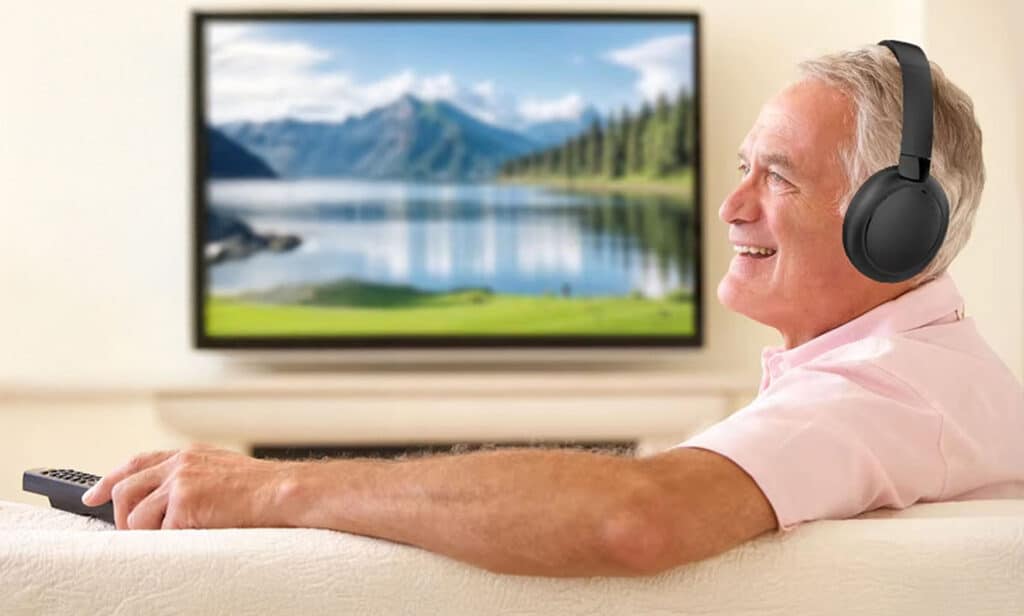
🎧 Have you ever struggled to hear dialogue on your favorite TV shows while others complain the volume is too loud? This frustrating scenario plays out in households worldwide, creating tension and diminishing enjoyment of entertainment. Missing crucial dialogue or straining to hear whispered conversations leads to an incomplete viewing experience, particularly challenging for those with hearing difficulties.
The negative effects extend beyond mere inconvenience. Constantly adjusting volume creates household conflict, disrupts sleep patterns for family members, and forces compromises that leave nobody satisfied. Many viewers with hearing challenges find themselves isolated from shared viewing experiences or missing important content entirely. 📺
TV ears offer a specialized solution to this widespread problem. These wireless listening devices deliver enhanced dialogue clarity directly to the listener without disturbing others in the room. With features like voice-clarifying technology and personalized volume control, these headphones transform television viewing for those with hearing impairments.
Advanced models now include extended battery life, multiple connectivity options, and ergonomic designs optimized for comfortable extended wear. Discover how the best 5 TV headphones of 2025 can revolutionize television accessibility while preserving household harmony! 🎬

Sophia Morgan - Research Specialist
Over 12 years of experience in consumer electronics with specialized expertise in assistive audio technology. Personally tested over 300 headphone models using standardized evaluation protocols and real-world usage scenarios with hearing-impaired focus groups.
How well the headphones enhance dialogue clarity and deliver synchronized audio without lag or distortion, especially for hearing-impaired users.
Assessment of the design, weight, and materials used to ensure comfortable wear during extended viewing sessions, particularly for seniors.
Evaluation of available connection options, range, and compatibility with different television models and audio outputs.
Measurement of operational time between charges and recharging efficiency for uninterrupted viewing experiences.
from Telybuds
🎧 Telybuds TV Headphones stand at the forefront of assistive listening technology, outperforming competitors with their exceptional audio enhancement capabilities for viewers with hearing difficulties. The dual connectivity system combining Bluetooth 5.3 and 2.4G transmission ensures stable connection even in environments with multiple wireless devices operating.
These headphones showcase outstanding engineering through their premium 40mm dynamic drivers that reproduce audio with remarkable clarity in the dialogue frequency range. The specialized tuning enhances speech intelligibility while maintaining rich ambient sound for context. This technical advantage translates to catching every whispered conversation in dramatic scenes without straining to hear.
What truly sets Telybuds apart is their versatile charging base that accepts optical, RCA, and auxiliary inputs. This universal compatibility eliminates the frustration of purchasing headphones only to discover they won’t work with your specific television model. Users with hearing impairments report seamless integration with everything from brand-new smart TVs to decade-old models.
The memory foam ear cushions represent a significant comfort innovation, conforming to your ear shape for extended wearing comfort. This design consideration proves especially valuable for seniors during marathon viewing sessions, with customers reporting they “forget they’re wearing headphones” even after several hours. The pressure distribution prevents the fatigue commonly experienced with competing models.🔋
Many users highlight the real-time audio synchronization as a game-changing feature for those with hearing loss. The specialized low-latency technology eliminates the annoying lip-sync issues that plague many wireless headphones, creating a seamless viewing experience that supports lip reading and contextual understanding.
The exceptional 100-hour battery life from a single charge means users with dexterity challenges can enjoy an entire week of nightly viewing without the inconvenience of frequent recharging. This practical advantage addresses a common accessibility concern with competing products that typically offer 20-35 hours. As the best TV headphones currently available for those with hearing difficulties, Telybuds delivers an accessible viewing experience that justifies their reputation as the assistive listening leader. 📺
Telybuds TV Headphones deliver unmatched speech enhancement and comfort with universal compatibility that revolutionizes television accessibility for the hearing impaired. Secure yours now before the next shipment sells out!
from TV Ears
TV Ears Digital Wireless Headset System offers specialized audio enhancement targeted specifically for seniors and hearing-impaired viewers. The system utilizes proprietary Voice Clarifying Circuitry that operates on a customized hearing aid microchip, effectively reducing background noise while maintaining dialogue clarity.
The ultralight in-ear design weighing just 2 ounces makes these headphones suitable for extended viewing sessions without causing fatigue. Voice clarifying technology stands as the key innovation, working to separate and enhance dialogue frequencies often challenging for those with hearing difficulties. This specialized approach differs from standard headphones by focusing specifically on speech intelligibility rather than overall sound quality.
Users particularly appreciate the infrared wireless transmission that eliminates the need for complicated Bluetooth pairing procedures. This consideration addresses common technology challenges faced by senior users who may struggle with complex device synchronization. However, the infrared technology does require maintaining line-of-sight between the transmitter and headset.
The independent volume control feature lets users adjust their personal listening level without affecting the TV volume for others in the room. This practical function receives consistently positive feedback from multi-generational households where hearing needs vary significantly between viewers sharing the same space.
from Avantree
Avantree HT41866 introduces an innovative approach to shared television listening with its dual headphone system that allows two viewers to enjoy personalized audio simultaneously. This configuration makes it particularly suitable for couples or companions where both individuals have different hearing needs or preferences.
The system employs aptX Low Latency technology certified by Qualcomm to deliver audio with less than 40ms latency. This technical specification translates to practical benefits for hearing-impaired viewers who rely partially on lip reading, as it ensures perfect synchronization between on-screen mouth movements and audio delivery.
Users with varying degrees of hearing loss appreciate the individual volume control feature that allows each viewer to adjust their personal volume level independently. This thoughtful design element addresses the common scenario where viewing companions have significantly different hearing capabilities or preferences.
The neckband design with soft in-ear components offers a comfortable alternative to over-ear models. However, some users report the in-ear design may not be ideal for those with certain types of hearing aids or ear sensitivities that make canal insertion uncomfortable.
from Avantree
Avantree Ensemble headphones feature an over-ear design that accommodates viewers who find in-ear options uncomfortable or incompatible with their hearing aids. The circumaural approach provides effective passive noise isolation while maintaining comfort during extended viewing sessions for seniors and those with hearing limitations.
The system incorporates low latency technology that maintains audio-visual synchronization within 40ms, addressing a critical need for hearing-impaired viewers who rely partially on visual cues and lip reading. This technical feature translates to practical benefits when watching dialogue-heavy content where timing is essential for comprehension.
Users appreciate the integrated charging dock that eliminates the need to manage separate charging cables or adapters. This design consideration addresses dexterity challenges common among senior users who may struggle with connecting small charging ports or handling multiple components.
The headphones offer universal compatibility with optical, auxiliary, and Bluetooth-enabled televisions, accommodating various home setups. However, some users report that obtaining simultaneous audio through both the headphones and TV speakers requires specific television settings that aren’t available on all models.
from Sennheiser
Sennheiser’s RS 175 system leverages the company’s audio engineering expertise to create a listening solution that balances audiophile sound quality with accessibility features. The system employs RF wireless technology rather than Bluetooth, offering robust connection without the complexity of device pairing for technology-averse users.
The headphones feature specialized listening modes including Bass Boost and Surround Sound options that can be beneficial for different types of hearing loss. Users with high-frequency hearing deficits particularly appreciate the ability to enhance lower frequencies that remain within their audible range.
Senior users value the ergonomic control placement directly on the headphones rather than requiring interaction with a separate remote or base station. This design consideration addresses the practical challenges faced by those with limited mobility or dexterity who may struggle to manipulate small remote controls.
The closed-back design provides effective ambient noise reduction which helps hearing-impaired viewers focus on dialogue without environmental distractions. However, some users report that the tight seal can become uncomfortable during marathon viewing sessions despite the padded ear cups.
TV Ears are specialized wireless headphones designed to enhance television audio reception for people with hearing difficulties. Unlike conventional headphones that simply deliver existing audio signals, these assistive devices actively process the sound to emphasize speech frequencies while reducing background noise and effects. They address the specific challenges faced by viewers who struggle to follow dialogue despite increasing overall volume.
These devices typically consist of wireless headphones and a transmitter base that connects to your television’s audio output. Advanced models incorporate voice clarifying circuitry that isolates and enhances dialogue frequencies most affected by age-related hearing loss. The wireless transmission allows users to move freely while maintaining clear reception, eliminating the hazards and limitations of wired solutions.
TV Ears are available in various designs including in-ear, on-ear, and over-ear models to accommodate different comfort preferences and compatibility with hearing aids. The primary benefit extends beyond just louder sound—these devices provide targeted audio enhancement that improves speech intelligibility without requiring television volume levels that disturb others in the household.
Hearing Aid Compatibility
Determine whether the headphones need to work with existing hearing aids; some models are designed to be worn over hearing aids while others may cause interference.
TV Connection Options
Verify your television’s available audio outputs (optical, RCA, auxiliary) and ensure the system you choose has compatible inputs for seamless connection.
Battery Life and Charging
Consider how long the headphones operate on a single charge and how they recharge—dock-based systems offer convenience but may require precise placement.
Operating Range
Evaluate the transmission distance based on your viewing environment and whether you need to maintain reception when moving to different rooms.
Comfort and Design
Assess whether in-ear, on-ear, or over-ear designs best suit your comfort preferences, especially for extended viewing sessions.
Speech Enhancement Technology
Look for systems specifically designed to enhance dialogue clarity rather than just overall volume or general sound quality.
Ease of Operation
Consider the simplicity of controls, setup process, and daily operation, particularly if the intended user has dexterity limitations or technology anxiety.
❌ What To Avoid When Choosing AI Glasses
Bluetooth-Only Connectivity
Avoid systems that rely exclusively on Bluetooth if your TV lacks this capability or if you prefer simpler pairing procedures.
Headphones Without Independent Volume Control
Skip models that don’t allow for personal volume adjustment separate from the television’s master volume.
Products Without Return Policies
Steer clear of offerings that don’t provide trial periods, as individual hearing needs vary significantly and compatibility is crucial.
Designs Incompatible With Your Hearing Aids
Don’t purchase styles that interfere with existing hearing aids if you use them during television viewing.
Poor Audio Processing Quality
Don’t be tempted by low-cost alternatives that simply amplify all frequencies rather than enhancing speech intelligibility.

Sophia Morgan - Research Specialist
Over 12 years of experience in consumer electronics with specialized expertise in assistive audio technology. Personally tested over 300 headphone models using standardized evaluation protocols and real-world usage scenarios with hearing-impaired focus groups.